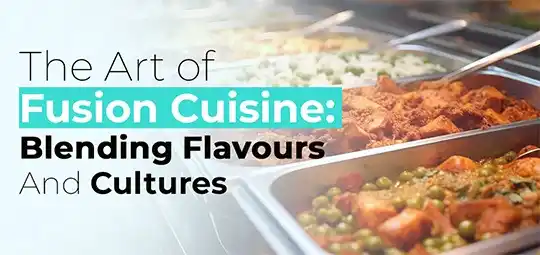Table of Contents
If there’s one thing in the world that brings people together, it’s the food. Transcending geographical boundaries and cultural differences, fusion cuisine combines the culinary traditions of two or more cultures. It has emerged as a vibrant expression of this global dialogue, combining elements from diverse culinary traditions to create innovative dishes that tantalise the palate. In the culinary world, fusion cuisine represents a celebration of diversity and creativity, by melding flavours, techniques, and cultural influences.
Understanding Fusion Cuisine
At its core, fusion cuisine is about breaking the rules of traditional cooking and experimenting with new combinations of ingredients and techniques. It allows chefs to showcase their creativity by integrating elements from different cultures, resulting in unique and unexpected flavour profiles.
While some people may argue that fusion cuisine risks diluting authentic culinary traditions, it can also be seen as a respectful homage to the cuisines, allowing for innovation while paying tribute to their roots.
The history of this concept is rich and varied, with influences tracing back centuries. From the spice trade that connected Europe, Asia, and Africa to the colonial era’s exchange of ingredients and cooking methods, the culinary landscape has always been shaped by migration and cultural exchange. Today, fusion cuisine is not just about creating new dishes; it reflects the global community’s shared experiences and the way food can bring people together.
The Origin of Fusion Cuisine
The early pioneers of the culinary world dared to push the boundaries of traditional cooking in the 1970s, setting the roots of fusion cuisine. This revolutionary approach to food originated in California and celebrates the multicultural background of the region by blending culinary techniques and ingredients from various cultures.
The popularity of this concept has since spread worldwide, embracing flavours and traditions beyond boundaries, The result is an ever-evolving culinary movement that transcends borders and customs, fusing seemingly disparate elements to create unforgettable dishes that delight the senses.
Elements to Consider For Successful Fusion Cuisine
Combining various tastes and techniques of cuisines requires careful consideration and understanding of the participating culinary traditions. Here are some essential elements, we at Jain Caterers, as one of the best caterers in Mumbai, keep in mind while crafting a fusion-inspired menu:
1. Flavour Profiles
The most crucial element is being familiar with the core flavours and ingredients of each culinary tradition. This knowledge helps in combining tastes and textures that complement each other, creating a harmonious balance on the palate.
2. Techniques and Preparation Methods
Experimenting with different cooking methods, such as grilling, steaming, or baking, as well as presentation techniques, lends an inventive global touch to your fusion dishes, but sticking to the traditional authentic methods of traditional food brings the taste of the land naturally, enhancing the flavours even more.
3. Balance and Harmony
Aim for a delicate balance between the flavours, textures, and ingredients, ensuring that no single element overpowers the others. A well-executed fusion dish exhibits harmony between the various components.
Some Fusion Cuisine Ideas To Inspire Your Event Menu
At Jain Caterers, we believe in experimenting with diverse flavours, textures and diverse cuisine traditions. Here are some inspiring examples of fusion cuisine that showcase the limitless possibilities of blending global flavours:
The Asian Fusion Cuisine
One of the most popular forms of this concept is Asian Fusion which combines elements from various Asian culinary traditions with those from Western cuisines. Asian fusion can encompass a wide array of influences, including Chinese, Japanese, Thai, and Korean, among others. This genre of cuisine often highlights the bold flavours and intricate techniques characteristic of Asian cooking, while also embracing the simplicity and presentation styles of Western dishes, at the same time.
The Indian Fusion Cuisine
Another exciting dimension of this concept is Indian fusion, where traditional Indian flavours and techniques are creatively blended with other culinary styles. Indian cuisine is known for its rich spices, aromatic herbs, and diverse cooking methods. When these elements are integrated with cuisines from around the world, the results can be both surprising and delicious.
One of the most popular fusion cuisines is to marry the aromatic spices and tangy flavours of Indian cuisine with the classic comfort of Italian dishes. For instance, try serving a Paneer tikka masala lasagna or prepare a fusion-inspired pizza with tandoori-spiced vegetables and a curry-infused tomato sauce.
The Future of Fusion Cuisine
As we move into a more globalised future, fusion cuisine will likely continue to evolve. Chefs are more willing than ever to explore new flavours and techniques, leading to exciting innovations. Food trucks, pop-up restaurants, and home cooks are experimenting with fusion dishes, making them accessible to a broader audience.
However, it is essential to approach this concept with respect and consideration. Authenticity is crucial, and while innovation is celebrated, it’s important to honour the traditions and histories that shape the dishes we create. Successful fusion cuisine strikes a balance between experimentation and respect for culinary heritage.
Conclusion
The art of fusion cuisine is a beautiful representation of our interconnected world. By blending flavours and cultures, chefs can create dishes that inspire and delight, reflecting the rich tapestry of human experience. Whether through Asian fusion or Indian fusion, the possibilities are endless. Explore the exciting combinations and celebrate the culinary innovations that arise from the melting pot of global cuisine. The next time you sit down to a meal that blends different culinary traditions, take a moment to appreciate the artistry behind it—because every bite tells a story of creativity, culture, and connection.

Leave a Reply